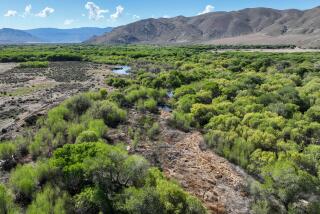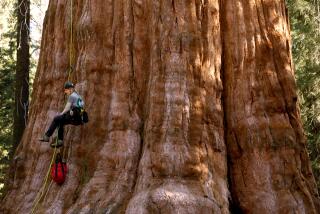Fuzzy Fungus Out on Forest Survival Limb With Spotted Owl : Ecology: To champions of ecosystem management, the furry sandoze in the Northwest is an important strand in the web of life, deserving of protection.
HUMPTULIPS, Wash. — Forget spotted owls. To see where the debate over saving America’s wildlife is heading, spend a day in the woods with ecologist David Shaw.
Drive with him deep into the Olympic National Forest, hike through a grove of ancient firs, totter the length of a mossy log, and peer, finally, around the base of a dead tree to behold . . . the fuzzy sandoze.
It’s a fungus. A very odd fungus, with a fruiting body that’s furry like a bear and sometimes as big, weighing up to 300 pounds. A very rare fungus, known from only six sites around the Northwest. And a very intriguing fungus, at least to scientists like Shaw.
“We don’t know its life history,” Shaw said, kneeling by the half-grown specimen he found in 1992. “We don’t know if it attacks live roots or strictly dead wood. We don’t know much about this fungus.”
All of which makes this fungus an ideal poster child in the campaign for ecosystem management, the latest theater in the war over imperiled wildlife.
The fuzzy sandoze, one of dozens of cryptic creatures protected under a new federal plan to manage Pacific Northwest forest lands, is not particularly cute. You can’t eat it. You can’t build anything with it.
But to champions of ecosystem management, the fuzzy sandoze is an important strand in the web of life, deserving of protection.
Where land management traditionally starts with a narrow goal--cutting timber, say, or saving a particular wildlife species--ecosystem management takes a broader view. The goal is a sustainable ecosystem, and any human activity is supposed to leave enough of the landscape intact to ensure the survival of all wildlife.
The idea isn’t new. But putting it into practice can be devilishly complicated, and there has never been a large-scale attempt to make it work--until now.
Hoping to end a three-year deadlock between wildlife protection and timber production, the Clinton Administration in April proposed a plan embracing ecosystem management across 24 million acres of federal forest land in Washington, Oregon and California.
A federal judge in Seattle must approve the plan for it to go into effect. He is to hear oral arguments Sept. 12.
What began as an effort to save a single species, the northern spotted owl, has evolved into a plan offering sanctuary to an ark full of creatures: salmon, sea birds, slugs, snails and, yes, the fuzzy sandoze.
*
Environmentalists view the Northwest experiment as a step toward more holistic wildlife conservation, an improvement over the species-by-species approach fostered by the Endangered Species Act, which is up for reauthorization by Congress.
But those who defend the use of natural resources see something more ominous--a government using analysis to create paralysis, enlisting ever more obscure organisms to prevent humans from carving out their own ecological niche.
In some ways, then, the forest plan resembles the forest itself--so big, so complex, that what you see depends on what you look for.
David Shaw is standing now, gazing up at 500-year-old firs and hemlocks.
“A logger looks at this and sees work,” he said. “I see a rich biotic environment.”
For years, his view didn’t count for much in a region where getting big logs out of the woods was the paramount concern.
Then, in 1991, U.S. District Judge William Dwyer in Seattle granted a request by environmentalists to temporarily ban logging across much of the Northwest’s national forest lands. Dwyer said the government had violated its own laws by not assessing logging’s effect on the spotted owl, listed in 1990 as threatened under the Endangered Species Act.
In 1992, when federal officials presented their spotted-owl plan, Dwyer rejected it, saying it did not meet National Forest Management Act requirements that viable populations of all wildlife be maintained.
Dwyer lifted the ban in June, in response to the government’s new forest proposal. But the judge said his action did not indicate how he would rule on the forest plan.
The result: These are busy times for scientists like Shaw.
They roam the forest in force, counting owls and other creatures. They sit at computers, using satellite imagery and multilayered, digitized maps to chart ecological connections.
The government’s scientific team studied how 10 logging scenarios would affect each of more than 1,100 species, from grizzly bears to lichens.
It was the most comprehensive study of its kind ever done. But Shaw says it barely scratched the surface of the forest ecosystem, where the bulk of biodiversity is made up of tiny, poorly understood organisms.
A cubic yard of forest soil may harbor 200,000 mites and tens of thousands of beetles, centipedes, springtails and spiders. High in the canopy, one spruce needle can support a world of fungi, lichen, insects and bacteria.
Shaw’s curiosity extends to both ends of trees. He got his doctorate in forest pathology, specializing in root rots. Now he’s leading a federally funded project to erect a 285-foot crane that will give researchers a bird’s-eye view of the old-growth canopy.
He stumbled across the fuzzy sandoze while scouting sites for the crane. It was an exciting moment, he says, and not just because of the novelty of the fungus.
“The fuzzy sandoze is important because it’s part of the process, not just because it’s unusual or rare,” Shaw said. “There’s work being carried out by ecosystems, and all the pieces are important.”
*
Late on a Friday afternoon in Portland, Ore., when most people were making tracks out of the city, Tom Tuchmann was in his office, pursuing the sticky business of turning science into public policy.
“People want more timber, more recreation, more biological diversity,” Tuchmann said. “At some point, we have to recognize that we have a limited land base, and then start making decisions about how much of each we want.”
Tuchmann, head of the Northwest office implementing the government’s new forest plan, knows how unpopular those decisions can be.
He must tell unemployed loggers that the region’s annual timber harvest will drop to one-fourth of its average during the 1980s. Then he must face lawsuit-prone conservationists and try to convince them it’s enough to protect 80% of the remaining old-growth, not 100%.
What Tuchmann sees in ecosystem management is a way to untie the knot of environmental laws and recent court rulings involving the old-growth forest. Protect habitat, he says, and you protect wildlife--including species that may be listed as endangered in years ahead.
“We’re trying to get ahead of the Endangered Species Act,” he said. “We feel that over time, we will have enough habitat to protect old-growth-related species.”
Environmental groups say the government’s plan points in the right direction but does not go far enough. They’re already drawing up new legal challenges.
The plan’s net effect can be put simply--more federal land for wildlife and less for loggers.
Thirty-six percent of the 24-million-acre planning area is already preserved as national park, wilderness or administratively withdrawn areas. The plan puts an additional 31% into old-growth reserves, and 11% into riparian reserves that will protect every river and stream with a forested buffer up to 600 feet wide.
Even in the 22% open to logging, the region’s familiar checkerboard of forested and clear-cut squares will give way to a more careful landscape.
Loggers will have to leave 15% of the trees in every watershed they cut. Dozens of rare plants and animals will get special protection wherever they’re found--100 acres around spotted-owl nests, 1.5 acres around the roosts of certain bats.
The fuzzy sandoze will fare especially well. Each specimen will get a 600-acre reserve until its needs are better known.
Bat buffers? Fungus reserves?
It’s the kind of talk that pushes Myron Ebell’s buttons. He works for the American Land Rights Assn., which represents private landowners and users of public lands.
Ebell says the forest plan is part of a “criminal conspiracy” to cripple the Northwest timber industry in the name of wildlife protection.
“If they’re able to move ahead, we’re going to see similar economic dislocations around the country,” he said.
Ecosystem management, by his definition, is a meaningless abstraction invoked by bureaucrats who want to exercise national land-use controls but lack the authority to do it.
Ebell says the current concern over endangered species is overwrought.
“Nature’s not fragile at all,” he said. “It’s an incredibly resilient thing. There are people who say any loss of genetic variety is a disaster, not admitting that any gaps are quickly filled by new species.”
But environmentalists, noting threats such as global warning, say humans have made a risky habit of modifying the environment in ignorance. They say that to ensure we’re not the gap filled by new species, more intelligent tinkering is needed.
“We are mere mortals trying to play God,” said Jim Pissot, Washington state representative of the National Audubon Society. “And we need a little more data to do that.”






